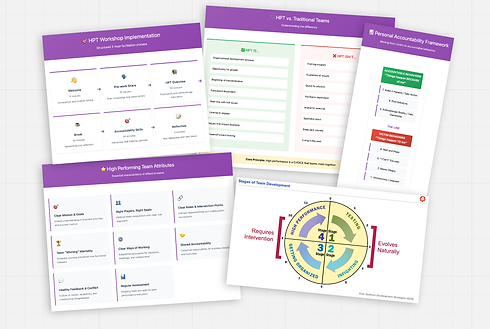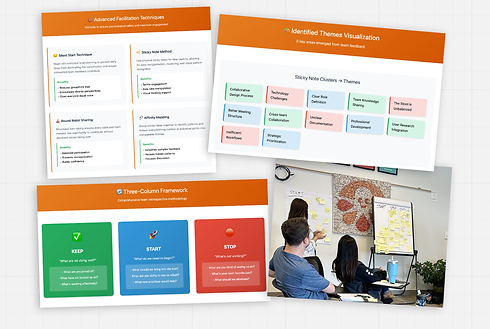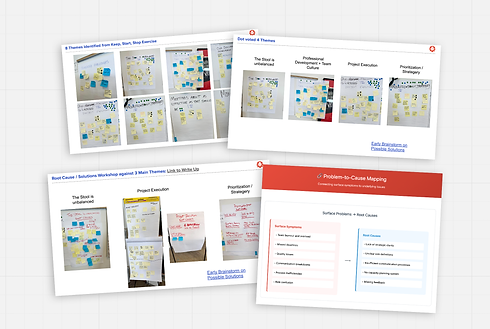
Leading Team Transformation
Designing and facilitating a comprehensive 2-day Connected Remote workshop to transform team dynamics and improve organizational effectiveness.
26
Team Members
(UX, Product + Engineering)
16%
Increase in Employee Satisfaction Score
2
Days of
Workshopping
Team in Crisis: Process Challenges
A 26-person eCommerce team was struggling with declining satisfaction scores (3.7/5), remote work isolation, and unclear processes that were impacting both morale and productivity.
Critical Pain Points
📉 Declining Satisfaction
Team satisfaction dropped to 3.7/5, well below historical 4.5+ baseline
🏝️ Team Isolation
26 people working remotely with minimal face-to-face interaction
❓Lack of Clarity
Team members didn't understand decision-making processes or priorities
🔄 Process Inefficiencies
Disconnected workflows and unclear ways of working
Team Survey Excerpts
"We need to examine how we are doing things NOW. Are we still using outdated processes that we may have evolved out of?"
"What does each role wish the other roles knew about their work? Where can communication be improved across roles?"
"I would love to address the gap between the different RACIs everyone has in their head."
Context: The eCommerce team (Product, UX, Engineering) had been working remotely with lots of new team members and limited in-person collaboration. The combination of remote work challenges and rapid team growth created disconnection and confusion about roles, processes, and strategic direction.
Design & Lead Comprehensive Team Transformation
I was tasked with designing and facilitating a comprehensive 2-day Connected Remote workshop to rebuild team connection, improve processes, and establish sustainable ways of working.
Cross-Functional e-Comm Team
👥
UX Team
2 Directors
5 Designers
🛠️
Engineering Team
1 VP
2 Directors
3 Managers
6 Engineers
📊
Product Team
1 VP
2 Directors
4 PMs
My Leadership Objectives
🤝 Foster Connection
Get team members to know each other personally and professionally
📋 Improve Processes
Identify and solve workflow inefficiencies and communication gaps
🎯 Establish Common Language
Create shared understanding of roles, responsibilities, and ways of working
🔍 Generate Actionable Solutions
Move beyond problem identification to concrete implementation plans
Success Criteria
✅ Improve team satisfaction scores
✅ Establish working groups for ongoing improvement
✅ Create clear action items with ownership
✅ Build enthusiasm for continued collaboration
✅ Develop sustainable follow-up processes
🧩 Leadership Challenge
As the facilitator, I needed to create psychological safety for 26 people to share honest feedback while maintaining momentum toward actionable solutions.
Strategic Workshop Design & Facilitation
I designed and led a strategic workshop combining HPT methodology, Keep/Start/Stop retrospectives, root cause analysis, and collaborative ideation to systematically identify problems and develop actionable solutions.

🗳️
Pre-Workshop
Survey + Planning
Conducted comprehensive team survey to establish baseline understanding of current pain points and operational inefficiencies.
Key Activities
📊 Pre-Session Survey
Identified team hopes, concerns, and priority topics
📅 Team Availability Analysis
Coordinated schedules for maximum participation
🎯 Curriculum Design
Created targeted agenda addressing specific team needs
🏢 Logistics Coordination
Secured venue, materials, and catering for optimal experience
📚
Day 1 - Morning
Intros + High Performing Team Overview
Leveraged Guttman Development Strategies' organizational development process focused on building enterprise accountability and team alignment through structured intervention.
Key Components
📊 Team Assessment
Conditions for Team Alignment pyramid (Vision & Strategy, Goals & Priorities, Roles & Responsibilities, Ways of Working, Business Relationships)
🎯 HPT Attributes
Clear mission/goals, right people in right seats, shared accountability, healthy feedback culture
📈 Team Development Stages
Understanding where teams naturally evolve vs. where intervention is needed


📝
Day 1 - Afternoon
Keep/Start/Stop Retrospective
Comprehensive team retrospective designed to capture what's working well, what needs to be introduced, and what should be eliminated from current ways of working.
Process Design
🧠 Individual Brainstorming
Silent generation of ideas using sticky notes
👥 Small Group Discussion
Table-based sharing and clustering of ideas
📊 Theme Identification
Grouping similar concepts to simplify discussion
🎯 Collaborative Share-Out
Teams posted findings for full group review
📊
Day 2 - Morning
Root Cause Analysis Workshop
After identifying 8 themes, used democratic dot voting to prioritize the top 4 issues, then facilitated deep-dive sessions to understand underlying causes rather than surface symptoms.
Facilitation Technique
🗳️ Democratic Voting
Each person got dots to vote on most important themes
👥 Breakout Groups
Teams of 6-8 focused on one theme each
🔍 5-Why Technique:
"What are the root causes? Why is this happening?"
📝 Structured Documentation
Visual mapping of problems to underlying causes
🛑 Mid-Flight Pivot: Narrowing Focus to Drive Clarity
The initial workshop plan included tackling all eight themes uncovered in Day 1. But by midday, it was clear that trying to tackle everything would dilute impact and burn out the group. I pivoted to prioritize the top four issues through voting and breakout sessions—trading breadth for depth. That shift gave the team clarity, ownership, and a realistic path to action.


📝
Day 2 - Afternoon
Collaborative Solution Ideation
Moved from problem identification to actionable solution development, ensuring each root cause had corresponding improvement strategies with clear ownership.
Implementation Framework
🧠 Brainstorming Rules
No judgment, build on ideas, quantity over quality initially
🏆 Prioritization Matrix
Impact vs. effort evaluation for solution ranking
📋 Action Planning
Specific next steps, timelines, and accountability partners
🎪 Commissioners Club
5-person working group formed to drive ongoing improvements
Measurable Team Transformation
This initiative fostered stronger cross-functional trust and equipped the team with tools to navigate remote work and overall process more effectively
16%
Increase in employee satisfaction scores within one quarter
5
Person working group "Commissioners Club" formed to drive ongoing improvements
4
Prioritized focus areas with clear next steps for improvement
Priority Themes Identified
⚖️ The Stool is Unbalanced
Team structure misalignment
🛠️ Project Execution
Process improvements needed
🧭 Prioritization/Strategy
Clearer decision-making frameworks
🌱 Professional Development
Team culture and growth opportunities
Long-Term Impact
Immediate Wins
✅ Bi-weekly Commissioners Club meetings established
✅ Monthly progress reports to larger team
✅ Clear action items with assigned owners
✅ Improved cross-functional communication
Sustained Change
✅ Methodology became standard for future offsites
✅ Process improvements implemented across teams
✅ Enhanced team cohesion and collaboration
✅ Replicable framework for other teams
💬
Post-Workshop Feedback
💬
By aligning on shared language and forming focused teams, we laid the groundwork for continued progress, now guided by clearer purpose, context, and sustained momentum
"We established a common language and created teams for each theme. The work is not over - the Commissioners Club will keep the momentum going."
"More context and setup for conversation was exactly what we needed. We now understand not just what we're doing, but how and why."
💡 Key Leadership Lessons
⏰
Timed for
Impact
Aligned with team pain points and leadership momentum to drive engagement and buy-in
👥
Co-Created
Solutions
Guided discovery sessions that empowered the team to shape and own the outcomes
🔄
Adaptive
Execution
Tailored the approach to minimize overhead and respect team bandwidth
🌱
Lasting
Transformation
Built shared understanding and accountability for sustainable change
💡 What I'd Do Differently Today
The workshop delivered lasting change—but team culture is never “done.” If I were leading this transformation today, I’d take it even further by:
📅
Add Pre-Workshop 1:1
Listening Sessions
Before kickoff, I’d schedule short, confidential interviews with a mix of team members. These sessions often reveal unspoken tensions or blind spots that surveys can’t catch.
🧭
Use a Team Maturity Model
for Self-Assessment
I’d give the team a shared framework (e.g. Tuckman stages or a custom maturity ladder) so they could self-assess progress before and after—building self-awareness and shared language from the outset.
🎯
Define “North Star”
Operating Principles
Together
Beyond solving tactical pain points, I’d co-create a set of team values or principles—like “assume good intent” or “prioritize progress over perfection”—to guide behavior when tensions resurface.
📊
Track Leading Indicators
of Culture Shift
Rather than wait for post-surveys, I’d track real-time signals: meeting sentiment, decision velocity, ownership handoffs, etc.—using pulse checks or team health tools to keep a live pulse on momentum.
🔁
Facilitate Peer Coaching
Groups Post-Workshop
To sustain the change, I’d spin up small peer coaching pods that meet monthly—turning alignment into habits and giving people space to reflect, vent, and recalibrate together.
📣
Spotlight and Celebrate
Progress Publicly
As teams improve, I’d create moments of visible recognition—highlighting improvements in communication, process, or collaboration—to reinforce what’s working and fuel ongoing buy-in.